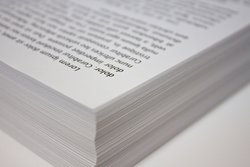

Use our online designer studio to create your own personalised flyers, business cards, greeting cards and more.
Order NowWhen it comes to professional printing and advice on your business marketing, we are the team to call! You can call us direct on 04 568 8773 or fill in our quote form.
Request a Quote
If you have contacted us about doing printing, you will get a quote back about the job and how it’s going to be printed, often including the term coated or uncoated paper. What does it mean and why is it important?
Simply put; uncoated paper is the same as the photocopy paper you get from stationery stores, while coated has a coat of fine white clay powder. This clay serves to make it whiter and smoother to ensure the best printing quality.
Paper is made from wood pulp, where the fibres in the grain are broken down to fine state then pressed to make the rolls/sheets of paper and card. These fibres give the paper a rough brown look that varies in colour with contrasting flecks. Take a look at a manila or kraft envelope or folder some time — that paper in its natural state.
The paper companies make it white by bleaching it but depending on who does it and how it is done, the paper has faint cast or tint ranging from blue to yellow. This cast can also be slightly different depending on the gsm rating and production batch. The wood fibre in the paper will leave a slight roughness to the page surface no matter how flat they press it giving a more ‘unfinished’ feel.
The uncoated paper is not bright pure white, which means anything printed on it becomes duller, the edges of coloured areas are not as crisp and the paper feels ‘rawer’ to a lot of individuals.
The clay used to make coated paper is naturally white and is blended to a very high standard to ensure a consistent bright white colour that coats the paper surface and gives it a smoother finish. This means that when printed on the colours printed on it equally bright and consistent with crisp edges to the colours. The feel of it is more ‘professional’ too.
Other factors to note:
That, in a nutshell, is the difference between Coated and Uncoated papers – just in case you cared!